Yakuo-in Temple in Mt. Takao is effectively one of the Shugendo monasteries.
Shugendo refers to the fusion of Buddhism and the Japanese mountain worship derived from Shinto, the indigenous religion of Japan based on nature worship.
Having said that, Yakuo-in Temple is now “officially” one of the three (3) head temples of the Chizan School of Shingon sect of Buddhism in the Kanto region along with the other two (2) Buddhist temples that are Narita-san Shinsho-ji Temple in Chiba prefecture and Kawasaki Daishi Heiken-ji Temple in Kanagawa prefecture.
The headquarters of the Chizan School of Shingon sect of Buddhism is Chishaku-in Temple in Kyoto.
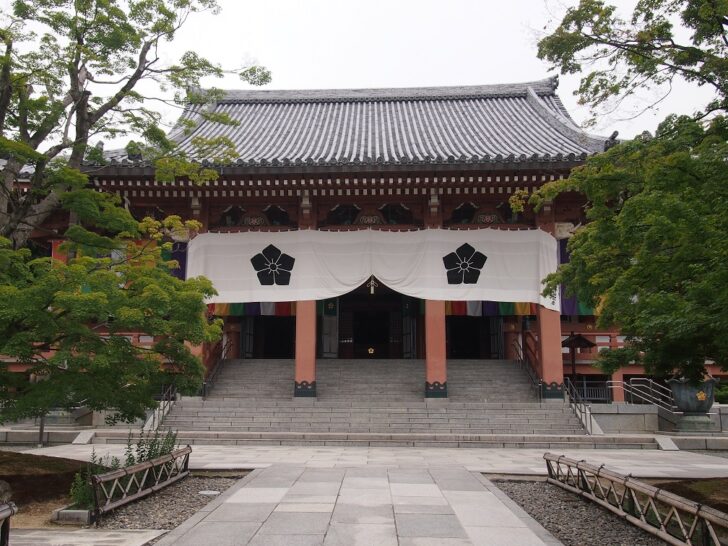
In connection with the relationship with the Shingon sect of Buddhism, there is a pilgrimage route in Mt. Takao that re-creates in miniature the eighty-eight (88) holy places of Shikoku
Shikoku is the smallest of Japan’s major islands.
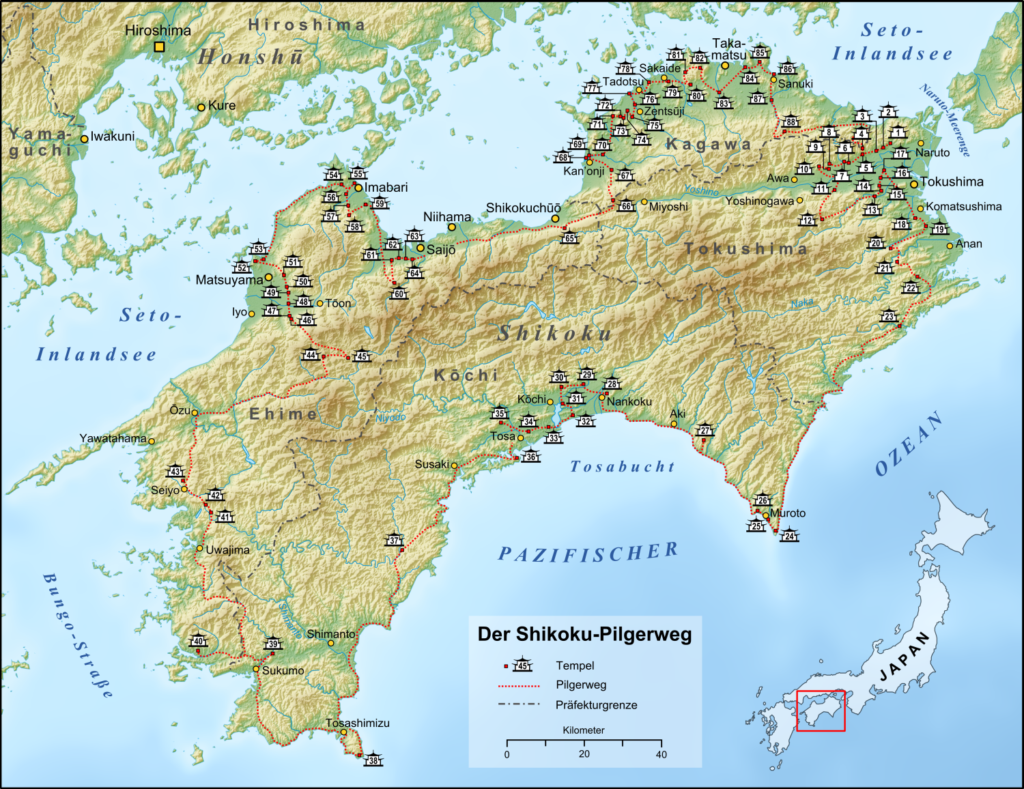
Shikoku pilgrimage has long been popular among Japanese people.
It dates back about 1200 years to the time when Kobo Daishi (literally, Great Priest Kobo) Kukai, the founder of Shingon sect of Buddhism, travelled around Shikoku to spread Buddhist teachings.
Shikoku is the birthplace of Kobo Daishi Kukai.
Kobo Daishi Kukai is enshrined at Daishi-do Hall, literally, Great Priest’s Hall, having the architectural style of a pyramid copper roof, in the grounds of Yakuo-in Temple in Mt. Takao.
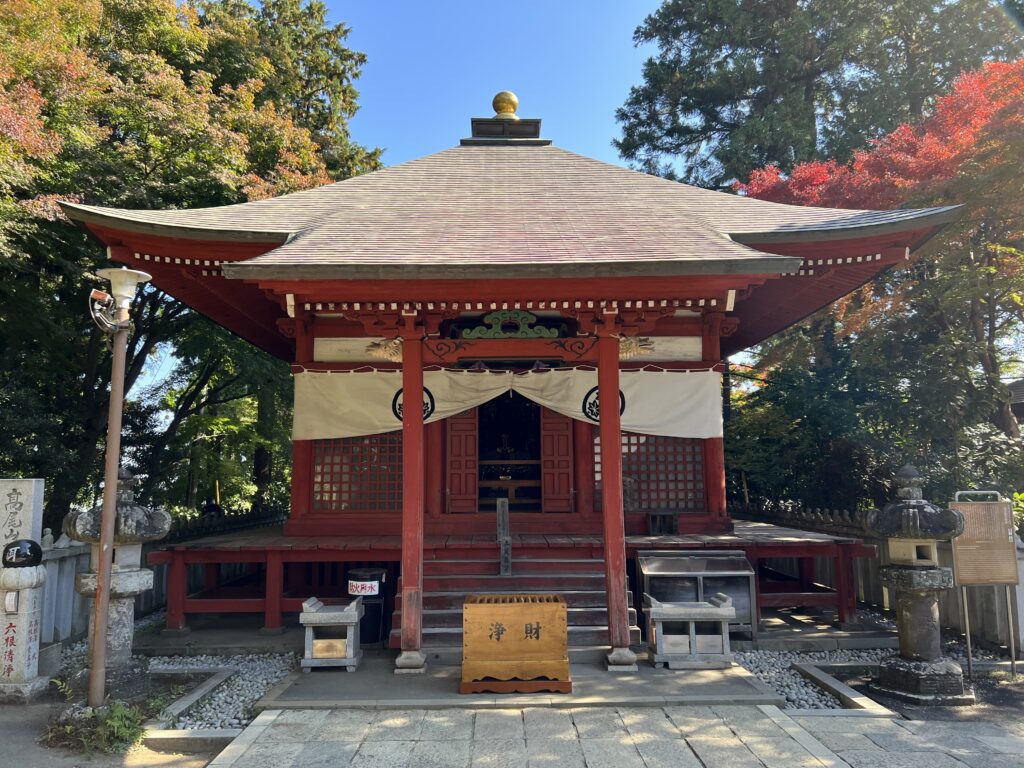
It is understood that this building had been called Dainichi-do Hall in the Edo period being located at the same place as the current main hall of Yakuo-in Temple that was built in 1901.
From its old name, we can reasonably assume that in the Edo period the building had been dedicated to Dainichi Nyorai, literally, Great Sun Buddha (Mahavirocana in Sanskrit) or its avatar, Fudo myo-o, literally, Immovable Wisdom King (Acalanatha in Sanskrit) before it was relocated to the current place next to the main hall of Yakuo-in Temple.
The building was originally constructed in the early 17th century and is designated as tangible cultural asset by the Tokyo Metropolitan Government.
The miniature pilgrimage course in Mt. Takao was established in the Meiji period after Yakuo-in Temple came to belong to the Chizan School of Shingon sect of Buddhism.
I guess that the creation of the miniature pilgrimage course was largely for the survival of Yakuo-in Temple as a Buddhist temple during the Meiji Restoration and its aftermath when Shugendo fell into a decline as a result of the issuance by the new Japanese government of a decree prohibiting Shugendo practice in 1872 that followed the Edict for the Separation of Buddhism and Shinto in 1868 making Shinto the national religion of Japan.
As you can imagine, at that time, Yakuo-in Temple had to demonstrate that it had been officially (and completely) transformed into a pure Shingon Buddhist temple.
That is, the 26th head priest of Yakuo-in Temple made a pilgrimage to the eighty-eight (88) holy places of Shikoku in 1903 collecting the soil at each of the holy places.
Then, he created the pilgrimage route in minature in Mt. Takao by enshrining the soil he collected from each of the eighty-eight (88) holy places of Shikoku.
This episode reminds me of the tradition of Japanese high school baseball players.
It is the dream of any young amateur baseball players in Japan to play in the nationwide high school baseball tournament held twice a year in spring (March) and summer (August) at Hanshin Koshien Stadium in the city of Nishinomiya, Hyogo prefecture.
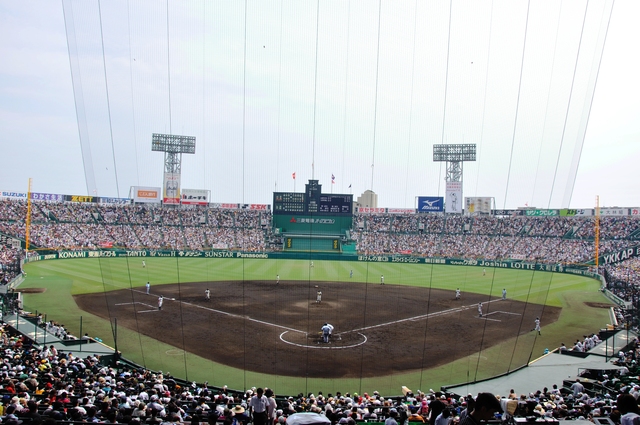
We could say that it is something like a pilgrimage for them to go through the local qualifying rounds and advance to the tournament held at this famous ballpark that is deemed the holy place for them.
If they should luckily advance to the tournament, even if they shouldn’t manage to win and advance further there, they will still have an opportunity to perform the “ritual” of taking a bit of the soil from the infield of this holy ballpark putting it in a bag to treasure the same for the rest of their lives.
Although baseball originated in the United States, like Judo, Kendo (one of the Japanese martial arts using bamboo swords) and other Japanese martial arts, the amateur baseball in Japan starts with a bow and ends with a bow.
Like Japanese martial arts gym called dojo in Japanese, which is a translation of Sanskrit bodhimanda (place of Buddhist practice or meditation), Hanshin Koshien Stadium is the highly spiritual and sacred place for high school baseball players.
In fact, out of the thirty (30) members of Samurai Japan that defeated the USA to win the 2023 World Baseball Classic, the majority including Shohei Otani and Yu Darvish were once the pilgrims who successfully advanced to the tournament held at the holy Hanshin Koshien Stadium in their high school days.
It is understood that after the death of Kobo Daishi Kukai, some priests initiated a pilgrimage retracing the steps that he had taken, which is the origin of Shikoku pilgrimage.
Centuries later, during the Edo period, many ordinary people started doing it as well.
To make a complete circuit of the Shikoku pilgrimage, the total distance is over 1,400 kilometers, which takes about two (2) months to complete on foot.
While it has traditionally been very popular to make the Shikoku pilgrimage, it would generally be a little too tough for many of the people to carry it out.
In fact, in the course of Shikoku pilgrimage, many of the pilgrims wear white robes similar to those worn by the dead.

Originally, this signified their wish to be buried on the spot if they should die during the long difficult journey.
At each temple, the pilgrims offer prayer slips called Osamefuda and recite a Buddhist sutra, typically, Prajna-para-mita sutra (hanya shingyou in Japanese), one of the shortest Buddhist sutra, the latter of which is also applicable to the pilgrimage in Mt. Takao.
It is believed that when they complete the pilgrimage, their prayers will be answered.
It is said that today some 150,000 – 200,000 people make the Shikoku pilgrimage every year.
Compared with the traditional Shikoku pilgrimage, the miniature course in Mt. Takao may be rather attractive to those who would like to earn the same amount of merit as from the actual Shikoku pilgrimage with much less time and effort.
Yakuo-in Temple holds a guided pilgrimage to the eighty-eight (88) sacred sites represented by eighty-eight (88) small stone carved statues of Kobo Daishi Kukai in this miniature course twice a year in spring (May) and autumn (October), each of which covers the half of the eighty-eight (88) sacred sites.

So, by participating in both events, you should be able to complete your pilgrimage which will take some seven (7) hours in total.
In the case of pilgrimage in Mt. Takao, one of the young monks in the costume of a mountain priest will play a role of your tour guide.

The first and the last holy places on the miniature pilgrimage route in Mt. Takao are both located around the starting point of Trail 1, which is the front approach to Yakuo-in Temple.
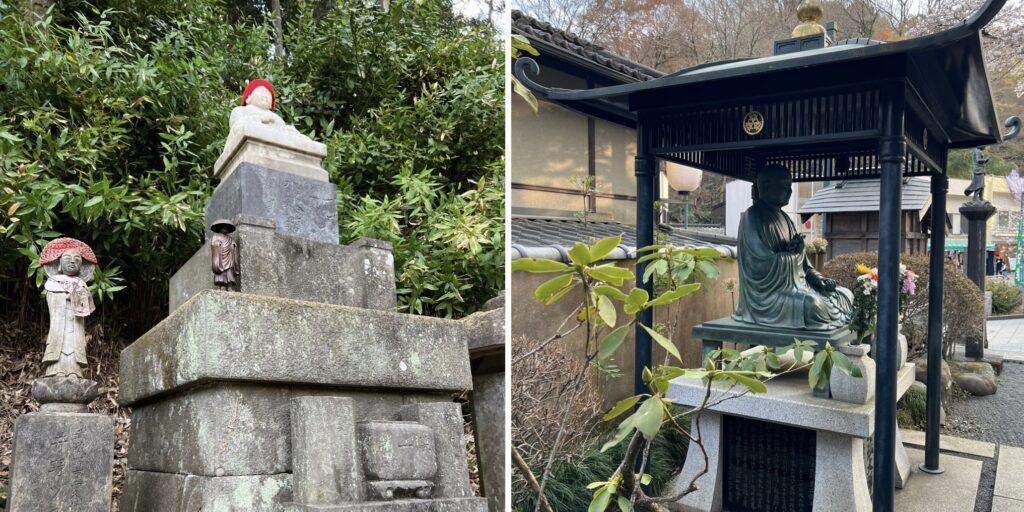
The participation fee for each event is JPY5,000.
Each pilgrimage includes the participation in the Goma Fire Ritual at the main hall of Yakuo-in Temple and a lunch of Buddhist vegetarian foods called “shojin-ryori” at the guest quarters of Yakuo-in Temple.
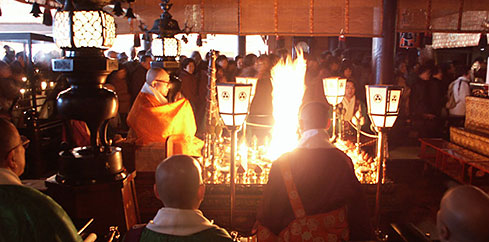
Shojin-ryori refers to a vegetarian meal prepared for Buddhist monks.
Following the Buddhist prohibition on taking any life, it contains no fish or meat.
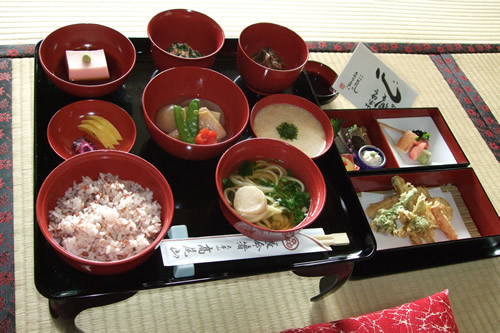
Having said that, I have heard that monks at Yakuo-in Temple usually have ordinary meals.
Separately from the guided pilgrimages mentioned above, visitors to Mt. Takao can try a course menu of shojin-ryori and also participate in the Goma Fire Ritual held everyday at the main hall of Yakuo-in Temple.
For “shojin-ryori” lunch, you are supposed to make a reservation (URL: https://www.takaosan.or.jp/english/) for which you might ask for help from your Japanese speaking hotel concierge.
In practice, it’s OK for pilgrims in Mt. Takao not to follow the formalities mentioned in relation to the Shikoku pilgrimage.
The dress code in Mt. Takao is not too strict and a fashionable outdoor wear would be OK since it is highly likely that you should be able to come back safely from the pilgrimage.
Having said that, it would be best if you can recite a Buddhist sutra called “Panja-para-mita sutra” during the pilgrimage while lip-syncing should also be workable.
As discussed in the post titled Izuna Daigongen as the ruler of Mt. Takao, Izuna Daigongen would be ready to deal with even the people who are full of worldly sins or desires.
In fact, Yakuo-in Temple offers, as a much easier alternative, one (1) minute circuit pilgrimage route around Daishi-do Hall for the convenience of even a hopeless idle fellow.
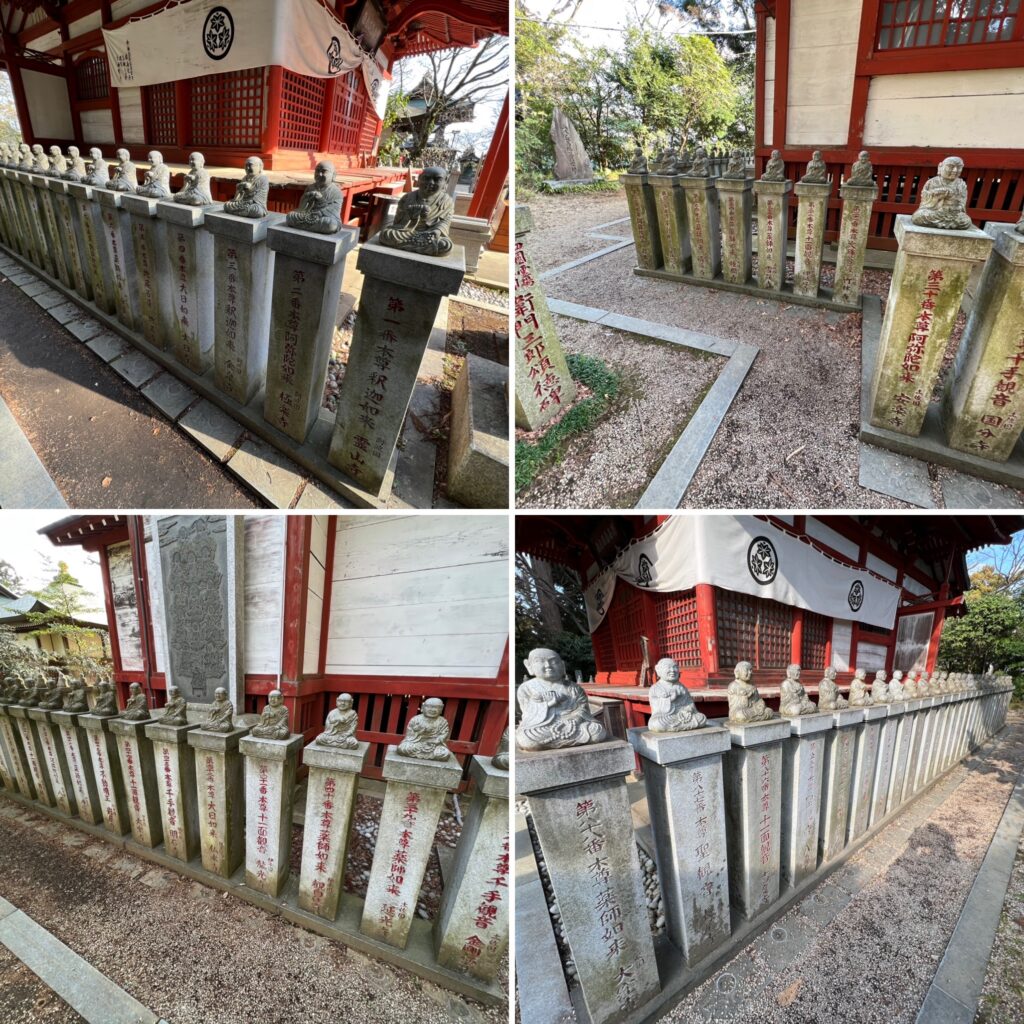
The minimum requirement is to donate one-yen for each holy place.
That is, so long as you have eighty-eight (88) one-yen coins, your prayers will be answered in one (1) minute.
I believe that you now understand that Mt. Takao is an ideal sacred mountain you should visit to make your prayers answered with much less time and effort.
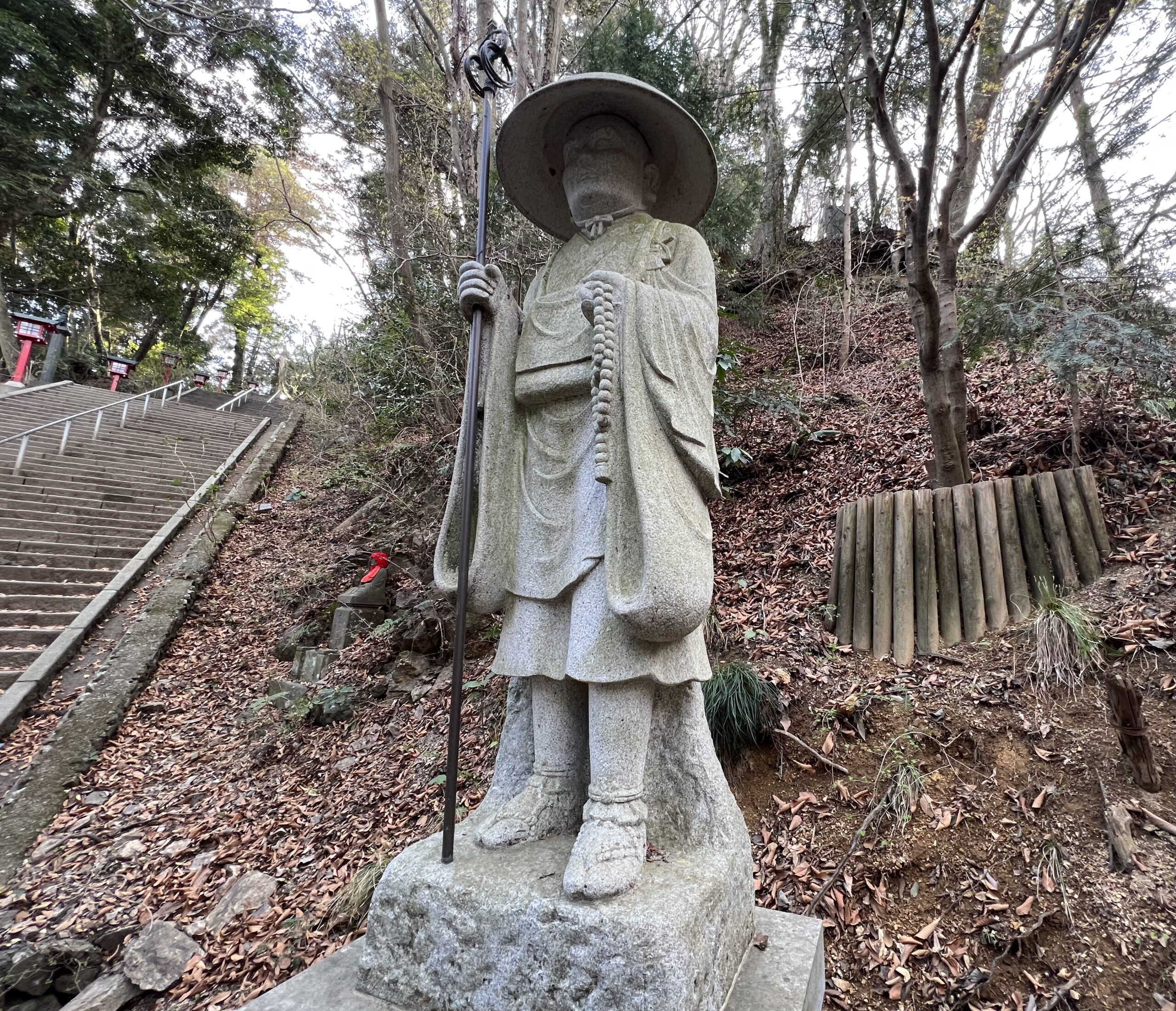
2 responses to “Shikoku pilgrimage in Mt. Takao”
I didn’t know there was a miniature version of the 88 pilgrimage routes in Shikoku on Mt. Takao.Here even lazy pilgrims like myself can walk.Shojin cuisine also looks very delicious.
I would recommend one (1) minute pilgrimage to eighty-eight (88) holy places around the Daishi-do Hall in the grounds of Yakuo-in Temple for you, an idle fellow.